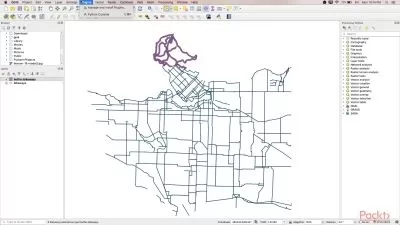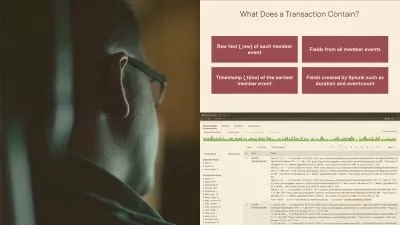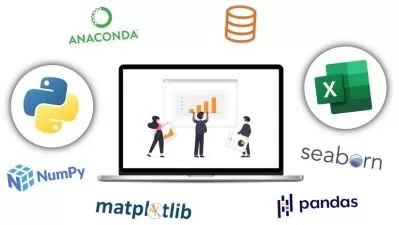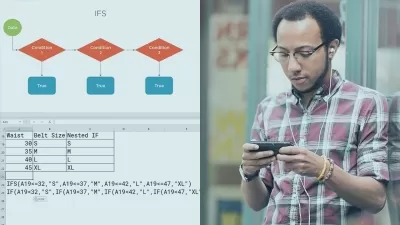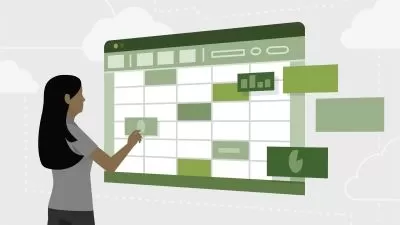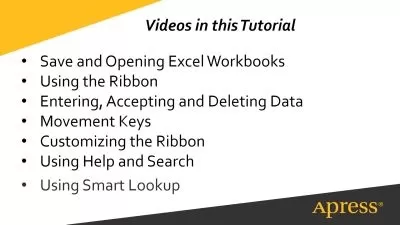The Data Analyst's Toolkit: Excel, SQL, Python, Power BI
Digital Learning Academy
11:58:51
Description
Data Mastery for the Modern Analyst: Excel, SQL, Python, and Power BI Techniques
What You'll Learn?
- The roles and responsibilities of a data analyst
- The importance of data-driven decision-making in organizations.
- How to use Microsoft Excel for data manipulation and analysis.
- Data cleaning and formatting techniques in Excel.
- How to create and use pivot tables
- Data visualization techniques using Excel charts.
- Writing basic SQL queries for data retrieval from relational databases.
- Advanced SQL techniques, such as filtering, sorting, aggregating, and joining multiple tables.
- The basics of the Python programming language for data analysis.
- How to use Python libraries like Pandas for data manipulation.
- Data visualization techniques using Python libraries such as Matplotlib.
- Connecting to data sources, data cleaning, and transformation in Power BI.
- Creating interactive dashboards and reports using Power BI.
Who is this for?
What You Need to Know?
More details
DescriptionThis course aims to provide students with a comprehensive understanding of the essential tools and techniques used by data analysts, including Excel, SQL, Python, and Power BI.
This course is a comprehensive course designed to equip aspiring data analysts and professionals with the essential skills and tools necessary to thrive in today's data-driven world. This course provides a solid foundation in data analysis, visualization, and communication, enabling students to make data-driven decisions and deliver actionable insights.
The course begins with an introduction to data analysis, delving into the roles and responsibilities of a data analyst, and the importance of data-driven decision-making. Students will then explore Microsoft Excel, a widely-used tool for data manipulation, analysis, and visualization. Through hands-on exercises, students will learn essential Excel techniques such as data cleaning, formatting, formulas, functions, pivot tables, and chart creation.
Next, the course introduces SQL, the standard language for managing and querying relational databases. Students will learn how to write basic SQL queries, filter, sort, aggregate data, join multiple tables, and use subqueries for advanced data retrieval. The course then dives into Python, a versatile programming language for data analysis. Students will learn some Python basics, including data types, control flow, and functions, before progressing to data manipulation with Pandas, as well as data visualization using Matplotlib.
As the course advances, students will explore Power BI, a powerful business intelligence tool for creating interactive visualizations and sharing insights across organizations. The Power BI module covers data connection, cleaning, transformation, modeling, relationships, and an introduction to DAX (Data Analysis Expressions). Students will learn how to create visually appealing and interactive dashboards and reports, customize visuals and themes, and share their findings with various stakeholders.
In the final weeks, the course will focus on integrating the tools and techniques learned throughout the program, including real-world case studies and applications in sales analysis, customer segmentation, social media analytics, operational efficiency, and financial analysis.
Upon completion, students will have a comprehensive understanding of the data analyst's toolkit and be equipped to tackle complex data analysis tasks using Excel, SQL, Python, and Power BI.
Whether you are an aspiring data analyst, a professional looking to enhance your skillset, or a business leader seeking to leverage data-driven insights, this course will provide you with the knowledge and tools necessary to succeed in today's data-driven world. Join us in this immersive learning experience and unlock the power of data analysis with the Data Analyst's Toolkit: Excel, SQL, Python, Power BI.
Who this course is for:
- Aspiring data analysts: Individuals who want to start a career in data analysis and are looking to acquire foundational skills in the field.
- Professionals seeking a career change: Professionals from other fields who want to transition to a data analysis role and need to develop their skillset in the most relevant tools and techniques.
- Existing data analysts: Data analysts who want to expand their knowledge of specific tools, improve their proficiency, or stay up-to-date with the latest industry trends.
- Business professionals and managers: Individuals involved in decision-making processes who want to leverage data-driven insights to make more informed decisions and gain a better understanding of the tools used by their data analysis teams.
- Students: College or university students studying business, economics, computer science, or other related fields who want to complement their academic knowledge with practical skills in data analysis.
- Researchers: Professionals involved in research who need to analyze and visualize large datasets to extract meaningful insights.
- Small business owners and entrepreneurs: Individuals who want to utilize data analysis techniques to optimize their business operations, improve customer experience, or identify new opportunities for growth.
- Freelancers and consultants: Professionals who provide data analysis services to clients and want to expand their toolkit to offer a wider range of services.
- Overall, this course is designed for anyone looking to acquire the skills necessary to efficiently analyze, visualize, and communicate data insights using Excel, SQL, Python, and Power BI.
This course aims to provide students with a comprehensive understanding of the essential tools and techniques used by data analysts, including Excel, SQL, Python, and Power BI.
This course is a comprehensive course designed to equip aspiring data analysts and professionals with the essential skills and tools necessary to thrive in today's data-driven world. This course provides a solid foundation in data analysis, visualization, and communication, enabling students to make data-driven decisions and deliver actionable insights.
The course begins with an introduction to data analysis, delving into the roles and responsibilities of a data analyst, and the importance of data-driven decision-making. Students will then explore Microsoft Excel, a widely-used tool for data manipulation, analysis, and visualization. Through hands-on exercises, students will learn essential Excel techniques such as data cleaning, formatting, formulas, functions, pivot tables, and chart creation.
Next, the course introduces SQL, the standard language for managing and querying relational databases. Students will learn how to write basic SQL queries, filter, sort, aggregate data, join multiple tables, and use subqueries for advanced data retrieval. The course then dives into Python, a versatile programming language for data analysis. Students will learn some Python basics, including data types, control flow, and functions, before progressing to data manipulation with Pandas, as well as data visualization using Matplotlib.
As the course advances, students will explore Power BI, a powerful business intelligence tool for creating interactive visualizations and sharing insights across organizations. The Power BI module covers data connection, cleaning, transformation, modeling, relationships, and an introduction to DAX (Data Analysis Expressions). Students will learn how to create visually appealing and interactive dashboards and reports, customize visuals and themes, and share their findings with various stakeholders.
In the final weeks, the course will focus on integrating the tools and techniques learned throughout the program, including real-world case studies and applications in sales analysis, customer segmentation, social media analytics, operational efficiency, and financial analysis.
Upon completion, students will have a comprehensive understanding of the data analyst's toolkit and be equipped to tackle complex data analysis tasks using Excel, SQL, Python, and Power BI.
Whether you are an aspiring data analyst, a professional looking to enhance your skillset, or a business leader seeking to leverage data-driven insights, this course will provide you with the knowledge and tools necessary to succeed in today's data-driven world. Join us in this immersive learning experience and unlock the power of data analysis with the Data Analyst's Toolkit: Excel, SQL, Python, Power BI.
Who this course is for:
- Aspiring data analysts: Individuals who want to start a career in data analysis and are looking to acquire foundational skills in the field.
- Professionals seeking a career change: Professionals from other fields who want to transition to a data analysis role and need to develop their skillset in the most relevant tools and techniques.
- Existing data analysts: Data analysts who want to expand their knowledge of specific tools, improve their proficiency, or stay up-to-date with the latest industry trends.
- Business professionals and managers: Individuals involved in decision-making processes who want to leverage data-driven insights to make more informed decisions and gain a better understanding of the tools used by their data analysis teams.
- Students: College or university students studying business, economics, computer science, or other related fields who want to complement their academic knowledge with practical skills in data analysis.
- Researchers: Professionals involved in research who need to analyze and visualize large datasets to extract meaningful insights.
- Small business owners and entrepreneurs: Individuals who want to utilize data analysis techniques to optimize their business operations, improve customer experience, or identify new opportunities for growth.
- Freelancers and consultants: Professionals who provide data analysis services to clients and want to expand their toolkit to offer a wider range of services.
- Overall, this course is designed for anyone looking to acquire the skills necessary to efficiently analyze, visualize, and communicate data insights using Excel, SQL, Python, and Power BI.
User Reviews
Rating
Digital Learning Academy
Instructor's Courses
Udemy
View courses Udemy- language english
- Training sessions 128
- duration 11:58:51
- Release Date 2023/06/24










